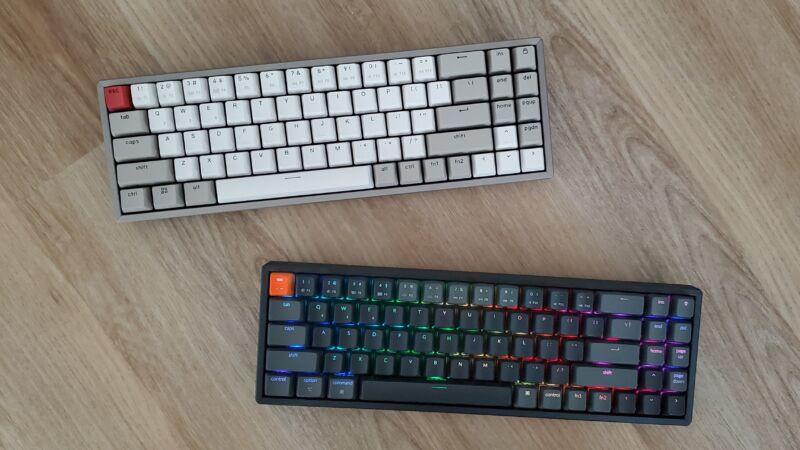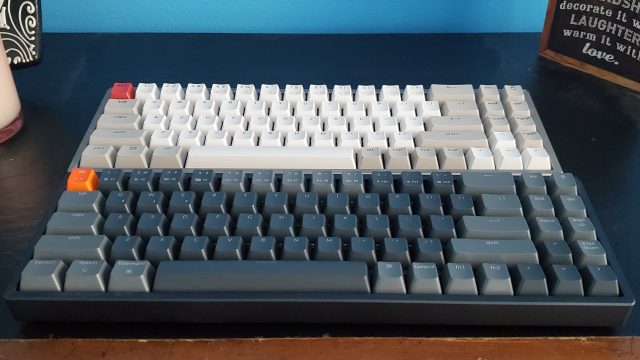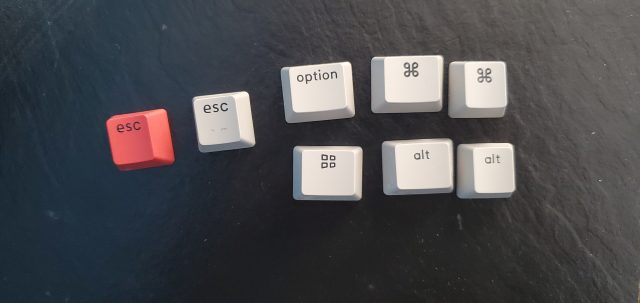
A common complaint about mechanical keyboards is that they're too expensive. Options are limited further for budget-minded buyers if they want a wireless device, especially if they're looking for a Mac-specific board. But the market has come a long way, and you can now pick up mechanical keyboards, including cable-free options, for under $100. And not only can you buy a wireless mechanical keyboard that works with Apple computers, but in the case of the Keychron K14, you can get one that comes with a Mac layout out of the box (don't worry, Windows keycaps are also included).
The K14 is a 70 percent wireless mechanical keyboard, meaning that it ditches the numpad (but not the navigation keys) and forgoes a dedicated function row. The result is a compact clacker with an option for white or RGB lighting and hot-swappable switches to get the exact typing feel you want.
The K14 even throws in some wireless luxuries, like the ability to pair the board with up to three Bluetooth devices and toggle between them, plus USB-C charging and the option to use the keyboard with a cable. At $59–$99, the K14 is a good candidate for someone seeking a budget- to mid-priced wireless keyboard with mechanical switches, and it's even better for those who want Apple-ready legends. For keyboard enthusiasts seeking the finest craftsmanship from sight to sound, though, some of the K14's features fall short.
| Specs at a glance: Keychron K14 | |||
|---|---|---|---|
| Worst | Best | As reviewed | |
| Switches | Keychron Red, Blue, or Brown | Gateron Red, Blue, or Brown, hot-swappable | Keychron Red, Blue, or Brown, hot-swappable |
| Keycaps | Doubleshot ABS plastic | ABS plastic | ABS plastic |
| Connectivity options | Bluetooth 5.1, USB-C to USB-A cable | ||
| Backlighting | None | RGB | None |
| Size | Plastic: 13.11×4.09×1.53 inches (333×104×38.85 mm) |
Plastic with aluminum: 13.27×4.25×1.53 inches (337×108×38.85 mm) |
Plastic with aluminum: 13.27×4.25×1.53 inches (337×108×38.85 mm) |
| Weight | Plastic: ~1.34 lbs (611 g) | Aluminum: ~1.62 lbs (735 g) | Aluminum: ~1.62 lbs (735 g) |
| Warranty | 1 year | ||
| Price (MSRP) | $59 | $99 | $79 |
| Other perks | Extra keycaps: 1x Esc, 1x Windows, 2x Alt; 1x USB-C to USB-A cable; 1x keycap puller | Extra keycaps: 1x Esc, 1x Windows, 2x Alt; 1x USB-C to USB-C cable; 1x keycap puller; 1x switch puller | Extra keycaps: 1x Esc, 1x Windows, 2x Alt; 1x USB-C to USB-C cable; 1x keycap puller; 1x switch puller |
Table of Contents
Differently priced options
Pricing for the K14 varies depending on the features you choose. The feature set will also affect the color scheme: white with light gray and red or dark gray with light gray and orange. You can get the K14 with a white or RGB backlight, but only with the dark gray keycaps. Keychron sells keycaps separately, but they don't have the same layout as the K14, which lets the number row serve as a function and media key row.
The cheapest version of the K14 has no backlight (except for a red indicator light for Caps Lock), and it comes with Keychron-brand switches that are soldered in. That means you would need a soldering iron and a lot of patience to change the keyboard's mechanical switches. More expensive SKUs, including the mid-priced K14 I tested, let you add hot-swappable mechanical switches so you can easily pop them out with an included tool. Gateron Red, Blue, or Brown switches are also available.
Oddly, a backlight results in a keycap downgrade. K14s with a backlight have ABS plastic keycaps, and those without a backlight use tougher doubleshot ABS plastic.
Finally, in order to get Gateron-brand mechanical switches instead of Keychron's, you'll need to order the K14 with the darker keycaps.
Disappointing keycaps
Keychron sent me a non-backlit K14 with white keycaps as well as the priciest option, which has dark gray keycaps and RGB backlighting. I much prefer the appearance of the non-backlit version. Both color schemes feel retro, but the white one is even more so. Plus, the white/non-backlit version has a bright look that lets you see the thicker legends with ease—even the gray legends for the function row and media keys.

The white version means no backlight, but the keys are so vibrant that I didn't miss the lighting. Plus, skipping a backlight helps extend the keyboard's battery life, and the non-backlit keys have doubleshot legends, so they won't fade (the gray legends on the top row are laser-engraved).
Still, it's unfortunate that Keychron forces you to make the decision instead of offering a white version with a backlight.
The K14 is one of the few mechanical keyboards—and even rarer, wireless mechanical keyboards—that caters to Mac users. The keyboard supports both macOS and Windows, as well as iOS and Android. But all K14s are shipped with a Mac layout, meaning that there are Option and Command keys where Windows and Alt are on Windows-based keyboards. Keychron includes the Windows alternatives in the box.

Meanwhile, Keychron offers a user group "to help with the experience" for Linux users.
reader comments
188